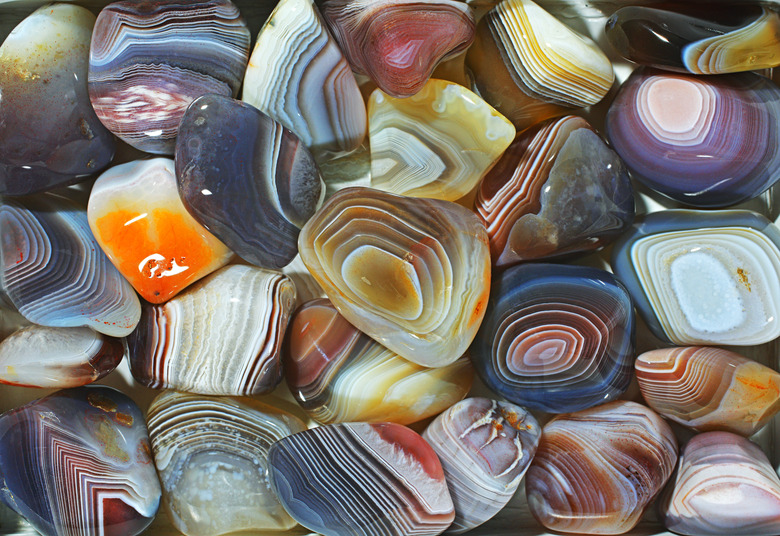How To Find Agates
Any geologist or 'rockhound' from around the world should be familiar with agates. The term agates refers to some types of chalcedony that have translucence, banding and/or other special color patterns. Agates can be found all over the world and there are thousands of varieties, each named and classified based on their colors and patterns. There are several locations in the United States where you can find agates, some of which are brilliant gemstones.
What Is Agate?
What Is Agate?
Agate is the name given to some types of translucent cryptocrystalline quartz that have been used as gemstones and for ornamental purposes for thousands of years. Quartz is one of the most common minerals that make up the Earth's crust. Both quartz and agate have identical chemical composition – they are made of silicon dioxide. There are two main types of quartz: crystalline quartz and cryptocrystalline quartz.
Crystalline quartz is the type of quartz that can form visible crystals, such as amethyst (purple), rose quartz (pink) or smoky quartz (gray). Cryptocrystalline quartz is also called chalcedony and does not form visible crystals – it is made up of crystals that can only be seen using a microscope.
Chalcedony is characterized by color and pattern. Agates are mostly made up of chalcedony with mineral inclusions and impurities that create unique colors and patterns. There are thousands of types of agates from around the world, distinguished from one another by their specific combination of colors and banding patterns. These are best observed when the stone is cut and polished.
Types of Agate
Types of Agate
While there are too many types of agate to review in a single article, some of the more popular and abundant types of agates include onyx, eye agate, moss agate, dendritic agate, fire agate and petrified wood agate.
Onyx is a banded type of agate that has parallel bands of color. Onyx typically has white bands alternating with black, brown or red bands. Eye agate, or ring agate, has bands that form a concentric, circular pattern which resemble eyes when polished.
Moss agate is a clear agate with green mineral inclusions that grow in patterns that look very plant-like. Another plant-like agate is dendritic agate, which has iron or manganese inclusions that grow in a branching pattern.
Found in the American Southwest, mostly in Arizona, fire agate forms in a botryoidal (grape-like) shape, and has iridescent rainbow patterns. Fire agate is very hard to polish because of its botryoidal nature and thin, alternating layers of iron oxides and silica that give this type of agate its iridescence.
Colorful agatized petrified wood is one of the most valuable commercial gemstones and can also be found in Arizona. The most colorful agatized petrified logs in the world can be found in the Petrified Forest National Park.
Where to Find Agates
Where to Find Agates
Agates can be found all around the world, in any location with past or present volcanic activity. Coastal locations or lakes are good places to find agates.
In the United States, agates are mostly found in Oregon, Washington, Idaho and Montana. Other southwestern and western states can be good agate localities – visit Arizona for fire agate and petrified wood, California for Mojave blue agate, or Colorado and Utah for some really amazing agates, jaspers and agatized fossils. Be sure to check before you collect – 'rockhounding' is not legal everywhere, and not all stones are up for grabs.
How to Find Agates
How to Find Agates
The first step to ensure success when hunting for agates is to choose a location where others have found agates before. Become familiar with the particular type of agate you are searching for – it is a good idea to look at pictures of the agates before going to search for them.
Some signs that a rock you find might be an agate include color bands, a waxy or glossy appearance, 'eyes' or spots of color, translucence or transparency, and other notable colors or patterns. Lightweight stones may be hollow agate geodes. Most agates are the size of a large nut or smaller, due to the way they form in cavities within volcanic rock.
You might want to dig for agates if you are in a popular agate locality. If the area has many visitors, most of the rocks that were sitting on the surface of the ground may have been picked up already. Digging will reveal agates that may have been hidden for eons!
Remember that the true colors of your agate will be revealed when it is polished or tumbled. A good way to determine what your agate will look like when polished is to get it wet – this can reveal color, pattern or translucence in your specimen.
What Are the Best Rocks to Tumble?
What Are the Best Rocks to Tumble?
If you are interested in rock tumbling, you may be interested in tumbling agates. Agates and other types of chalcedony are some of the best rocks to tumble, because they are hard enough to withstand the stress of tumbling and also they tend to make very beautiful polished specimens.
When choosing rocks to tumble, try to choose those that have no cracks or holes. Select stones that are all of a similar size (the appropriate size will depend on the size of your rock tumbler). Choosing stones of the same material and hardness will produce the best batch of tumbled stones.
Cite This Article
MLA
Reinbold, Joan. "How To Find Agates" sciencing.com, https://www.sciencing.com/agates-6939327/. 30 September 2021.
APA
Reinbold, Joan. (2021, September 30). How To Find Agates. sciencing.com. Retrieved from https://www.sciencing.com/agates-6939327/
Chicago
Reinbold, Joan. How To Find Agates last modified August 30, 2022. https://www.sciencing.com/agates-6939327/
